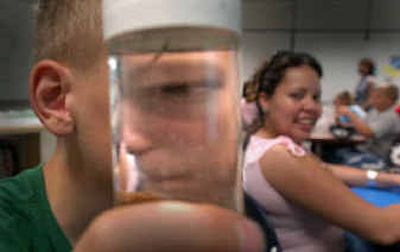Everybody learns at English language camp

Ask Darya Kuznetsova what she thinks about Gonzaga University’s summer language camp and her body language will give away the answer before she can get the words out.
Bouncing on one leg as she worked to form a lump of gray clay into a Navajo dwelling, the 10-year-old said: “I love it here! I like making stuff and the teachers are so nice.”
Now a Cooper Elementary School student, Kuznetsova came from Ukraine three years ago. This summer, she is one of about 58 students from China, Ethiopia, India, Korea, Mexico, Moldavia, Russia, Switzerland, Taiwan, Ukraine and Vietnam spending three weeks at Gonzaga’s English language camp. It runs through July 30.
For six years, Gonzaga has been teaming with Spokane Public Schools to provide a free language camp to students and parents in the district who are learning English.
But the camp serves a dual purpose. Besides teaching English to non-native speakers, the camp also provides teachers in the summer institute an eager group of students.
Participants in GU’s Teaching English to Speakers of Other Languages summer institute spend three hours in class each morning learning the best way to teach English. With the afternoon language camp, they assist the classroom teachers and put the morning’s theories into practice with a small group of students. The last week of camp, they will be given control of the language camp classroom, and get real practice being in charge of a larger group of kids.
“I like having so much interaction with students,” said summer institute student Annie Platt. Recently graduated from Asbury College in Kentucky, she and her husband came to Gonzaga for the summer because they are thinking about teaching English in Taiwan. “It is stressful, though, being with students after just two days.”
“I’m impressed,” added summer institute student Mary Quinn. She plans to teach at a boarding school in Kansas in the fall. “They fit a lot of information into a short amount of time, but it’s so fun you don’t feel bogged down. And I love how the language camp is so hands-on.”
The language camp welcomes English language students age 5-18 and adults. The adults have their own class, but kids are divided by age, each group studying a different habitat. The 17 students in the 9- to 12-year-old age group have been studying the desert.
Within each group is a range of English abilities. Some have only been in the country a few weeks and answer most everything with a nod or shake of the head. Others, like 10-year-old Jack Luo, who came from China two years ago, have no problem yelling out answers during a game of Pictionary. His class used the game Monday to review its list of desert vocabulary words. Urged on by their classmates, even the shyest students eventually took a turn at the board, trying to draw “mesa” or “sandstorm” or “erosion” well enough for their teammates to guess the word.
“It’s fun,” said David Chavez, 9, who attends Logan Elementary School. Chavez said he has always lived in Spokane, but his parents came from Mexico. He speaks both Spanish and English. “We meet new friends and learn about deserts. I didn’t know what a playa or a dust devil was.”
The best part of camp, though, happens on Fridays, when the class with the best attendance gets to throw water balloons at their teachers.
“That’s the bomb,” said Chavez.